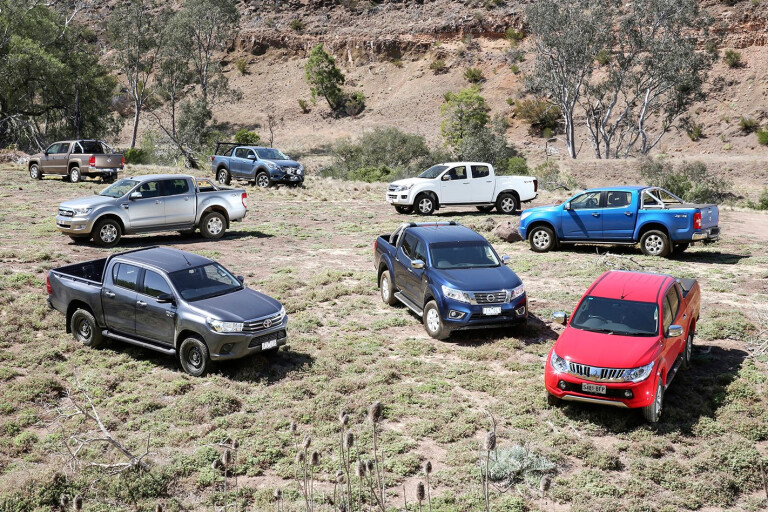
AUSSIES are long-term utilitarians. It’s a lifestyle choice that can be traced back to 1932, when a farmer’s wife asked Ford Australia for “a vehicle to go to church in on a Sunday and which can carry our pigs to market on Mondays”. Ford responded with its 1934 ‘coupe utility’ and so began a ‘trayed’ union, now spanning eight decades.
But which of the current dual-cab crop is best? We took eight examples, all of which cost around $50K, to Melbourne’s 4x4 Training and Proving Ground in Mount Cottrell to find out.
8. Isuzu D-Max LS-U Crew Cab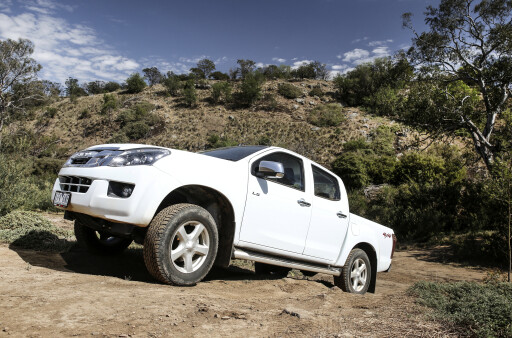
‘HONEST’ describes the Isuzu D-Max. Although it shares its GM-developed body and chassis with the Holden Colorado, Isuzu brought its own engine and gearbox. And the D-Max’s generations-old donk is a big part of its honesty. A commercial engine, it lives up to all the connotations the word ‘truck’ brings, both good and bad.
Similarly, the gearbox is a proven Aisin unit that has seen duty in the Toyota Prado, among others.
Despite its basic appearance, the requisite equipment is mostly there in LS-U spec, which features six airbags, Bluetooth audio and, erm, carpet. You also get 17-inch alloys, projector headlights and front fog lights, LED tail-lights, aluminium side steps and extra chrome trim.
The 3.0-litre turbo-diesel four-cylinder is gruff and comparatively noisy. With 130kW and 380Nm, it’s not the most powerful, either, though the longevity of an under-stressed truck mill is an appealing prospect. Wind, tyre and suspension noise filter into the cabin more freely than they do in the more refined Amarok and Ranger, which will make the D-Max more tiring for long trips. Back-seaters have it worse, courtesy of a lack of under-thigh support and a too-upright backrest, though head and shoulder room are good.
7. Holden Colorado LTZ Crew Cab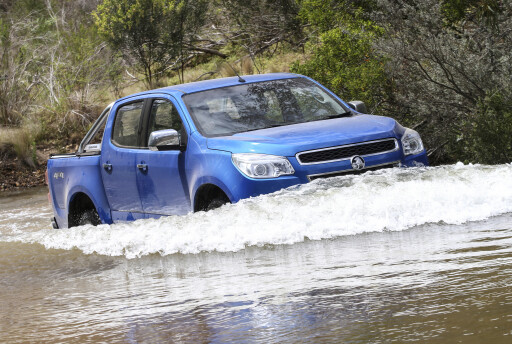
HOLDEN’S entrant may have a face that clearly links it to the family, and a Lion logo the size of a Frisbee, but it was developed by GM in Brazil, has an Italian engine, is built in Thailand, and shares chassis and body hardpoints with the Isuzu D-Max. It has a lack of cabin ambience, hard plastics, flimsy storage compartment lids, fussy and dated instruments, and even in LTZ spec (a grade higher than much of the field tested), any sort of service like navigation requires your smartphone and your data.
This could be overlooked if the powertrain was a model of refinement and efficiency, but it’s not. The big four-pot – 2.8 litres, force-fed by a single turbo – comes from VM Motori, now owned by Fiat-Chrysler.
Despite the addition of extra sound insulation as part of last year’s MY15 upgrades, it’s still loud for this class and objects to being revved. On the road, the big Holden gets a passable grade – provided you don’t ask too much of it. The engine’s gruffness and noise is only intrusive beyond the peak power point, and GM’s six-speed auto does a decent job of upshifting early to tap into the bottom of the solid, but narrow, torque spread to keep the big rig surfing along. On any typically lumpy B-road there’s a problem with the relationship between the cabin and what’s going on down at road level. Hit a bumpy section and the wheel shimmies in your hands, as the whole plot quivers and quakes.
On dirt, the ESC is deftly calibrated to quickly curb spinning wheels and gently restrict slides, but over corrugations the steering kickback reaches eye-widening levels. It’s a shame the platform and engine are well short of what’s needed, but Holden is working on another round of upgrades.
6. Mitsubishi Triton GLS Double Cab
SIMPLY being the best drive in class doesn’t automatically make a car a best-seller, but brilliant value for money is a sure-fire way to make an impression on buyers. And that’s Mitsubishi’s approach with the Triton.
The launch of the fifth-gen model in May 2015 helped Triton’s buck-beating credentials while attempting to bring its on-road and off-road abilities closer to those of its rivals. Our mid-spec Triton GLS auto brings safety features such as ESC, a driver’s knee airbag and a reversing camera to put it firmly in the family-car frame. A five-star ANCAP crash rating is a must, while hill-start and trailer-stability assist systems are nice to have. Dual-zone climate, HID headlights, LED DRLs, fog lights and a sporty styling package with 17-inch alloys add to the attraction.
The GLS-spec side-steps make the Triton easy to get in and out of, and redesigned front seats banish the old model’s legs-out-in-front seating position for a more comfortable, upright position. The new Triton’s cabin is 20mm longer, almost entirely translated into rear legroom, with more head and shoulder room as well. Triton’s update included measures to better suppress combustion noise and a revised injection system on the 2.4-litre turbo-diesel.
Aussie suspension tuning sought to improve high-speed stability on gravel roads, but it hasn’t smoothed the ride, which remains jittery on lumpy surfaces.
A beefier new five-speed auto means all Tritons now get the full dose of torque (a stout 430Nm, up 80Nm). In practice the Mitsubishi isn’t as instantly punchy as some of its rivals, but it powers along with authority from the peak torque point of 2500rpm to the 4000rpm redline.
Triton isn’t the best ute off-road – or on it – but considering its roominess, equipment level and affordable pricing, plus the fact it’s well-mannered and capable enough for most buyers, we can still see the appeal.
5. Nissan Navara ST Dual Cab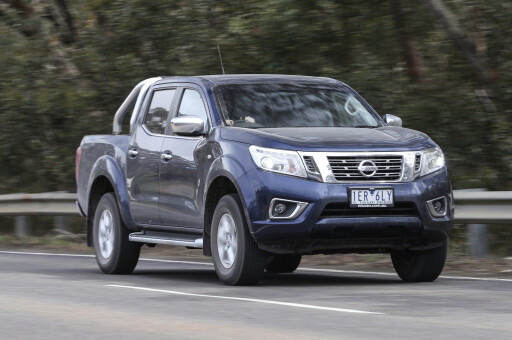
NISSAN’S NP300 Navara has the makings of a segment-shaker. It packs an efficient 2.3-litre Renault-Nissan diesel with twin turbos (in the upper and mid-spec versions), a stout 3500kg towing capacity and five-link rear suspension with coil springs (in all dual-cab versions) when all its rivals still use rear leaf springs.
From comfortable front seats trimmed in a suede-like soft trim, front occupants are presented with a neat dash headlined by a 5.0-inch audio unit comprising Bluetooth connectivity for phone and music, smartphone integration and a reversing camera. Standard features include seven airbags and auto headlights, and the ST adds self-levelling LED headlights, LED running lights and front fog lights, side-steps, a rear diff lock and 16-inch alloys.
The five-link rear suspension promises plenty, though it’s difficult to juggle unladen ride comfort with a heavy-duty cargo/towing capacity. The required stiff coil springs mean the road ride is jittery, despite more sophisticated suspension design, though the damping is relatively soft, tending to float rather than jar, which leaves ride quality as merely ‘good’.
The 2.3-litre diesel makes use of its twin sequential turbos to torque convincingly from low revs – peak twist of 450Nm is delivered from 1500-2500rpm – while also providing a thrusty mid-range that runs to the 140kW peak at 3750rpm.
4. Toyota Hilux SR Double Cab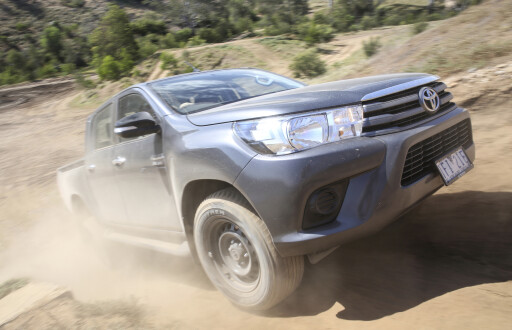
TOYOTA’S ownership of this segment was once so absolute that ‘Hilux’ just about became the non-enthusiast’s term for anything that resembles a 4x4 ute. Intensifying competition saw Toyota really ramp up development for this eighth-generation model, as well as increasing Toyota Australia’s involvement in all aspects ranging from dynamics to load carrying and accessories.
You still get traditional Toyota virtues like rock-solid reliability and resale value, idiot-proof functionality and the confidence you’ve made a solid, gamble-free choice. However, you also get a 4x4 ute well short of best-in-class for dynamics and on-road performance. We won’t sugar-coat this: The all-new Hilux is, compared to the standard-setter, stiff and bouncy in its ride, neither fast nor frugal, and downmarket in its interior accommodation.
The cabin might be all-new, but the design is a collision of mismatched surfaces and too many ideas. The only element that looks remotely contemporary is the multimedia screen.
On the plus side, the driving position, ergonomic details and general functionality are fine; it just feels like a site office on wheels.
Then there’s the suspension tune: the Hilux SR is one stiff, unforgiving brute over Aussie backroads. The upside may be crisp steering and better body control than the tail-enders, but it’s still hard to reconcile the trade-off for a recreational cruiser.
3. Mazda BT-50 XTR Dual Cab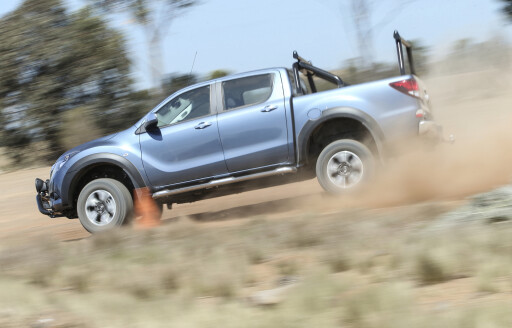
THE BT-50 was co-developed with the Ford Ranger, and in terms of chassis and powertrain fundamentals, there’s little to separate the two.
Mazda wanted its BT-50 to deliver a bit more ‘zoom-zoom’, so it has a slightly quicker steering rack and slightly firmer dampers. And, since last year’s upgrade, the Ranger has electric power steering assistance while the Mazda continues with hydraulic assistance. On the road, especially at a brisk cruise, that’s no bad thing, but off-road, the Mazda struggles to keep up, whereas the Ford’s wheel spins quickly and fluently from lock to lock.
The 3.2-litre five-cylinder that powers both the Mazda and Ford is a mid-fielder in terms of NVH – notably short of the muted Amarok, yet comfortably ahead of the raucous Colorado and D-Max. Still, the BT-50 feels quick enough, and its six-speed auto is well calibrated to deliver intuitive shifts.
We also like the cabin and its simpler execution of instruments and minor controls, compared with the Ranger. No prizes for the Mazda in the back, though, where rear passengers are forced into a too-upright position, with legs bent at a sharp angle and little under-thigh support. No rear vents, either.
So the BT-50 finds itself on the podium, doing most things reasonably well, if short of the Ranger in a few key areas.
2. Ford Ranger XLT Double Cab
WHILE it was once possible to consider the Mazda BT-50 and Ford Ranger the same, a 2015 facelift introduced noticeable mechanical and cosmetic differences.
This departure is evident as soon as you turn the wheel. A new electric power steering system provides light, smooth steering which makes the Ford easy to wheel around the suburbs.
As speeds rise, the weighting becomes more natural, without the wheel losing its lovely, frictionless feel. This steering system is where the Ranger really stands head and shoulders above its rivals.
But there’s more than one area in which the Ford ute stamps its authority on the segment. Its 3.2-litre five-pot sounds good, has impressive 147kW/470Nm outputs, and has improved refinement thanks to quieter new injectors and cylinder-head revisions as part of last year’s facelift.
The Ranger also has a more compliant ride on bitumen surfaces than its Mazda sibling. Off the beaten track, the big Ford takes it all in its broad stride, dismissing even the most challenging climbs with insouciance and a minimum of wheelspin. It’s not quite as accomplished as the Hilux, but the Ranger will take you just about anywhere you’d expect with a standard roadgoing 4x4.
1. Volkswagen Amarok Highline TDI420 Dual Cab
IF THE rest of this field is clearly from working-class stock, the VW is a cut above. The others may be solid blue-collar performers, but the VW Amarok creates the impression it’s the only one with a university degree, capable of not spending its life on the tools. It feels polished, with a sheen of sophistication.
Take the refined and (relatively) revvy 2.2-litre twin-turbo four. At idle it’s nicely muted and clatter-free; but this is also an engine that welcomes hard work. The transition from small turbo to larger one is fluid and impossible to pick, the peak torque smeared across a generous curve.
The powertrain’s refinement is mirrored in the chassis. It has none of the wobbles and tremors that plague its rivals to varying degrees. And the suspension tune is excellent.
Further proof VW has it right comes when you heel it into a few bends. It leans without pushing into early understeer and responds to the throttle mid-bend to allow subtle line adjustments.
Sealing the deal is a level of interior presentation, comfort and refinement that feels Business Class to the others’ Economy. Add to that the widest cabin in its class – even three teenagers sitting across the back won’t complain – and a tray capable of swallowing a full-size pallet, and you can see how Amarok brains the competition in almost all key areas.
COMMENTS